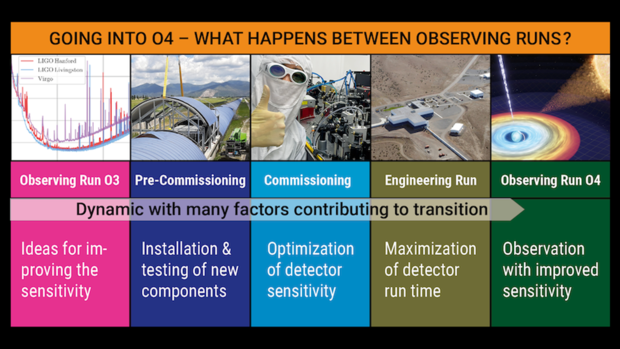
Infographic explaining the transition between observing runs. [Image credit: LIGO/Virgo/KAGRA]
LIGO and its Partners Fast Approaching Next Observing Run
News Release • May 16, 2023
The LIGO-Virgo-KAGRA collaboration is making progress towards the start of the next observing run. After three years of work to improve the performance of the detectors, Observing Run 4 (O4) is planned to start on May 24th, 2023. The LIGO detectors have moved from commissioning to running in engineering mode in preparation for O4. Virgo is also running in engineering mode, but for a limited fraction of time, giving priority to commissioning activities aimed at improving their sensitivity. KAGRA will continue commissioning up to one week before the start of O4 to improve sensitivity. The aim of this collaborative engineering run is to test the upgraded instruments and the systems required for the network of detectors to observe together.
The latest upgrades to the LIGO and Virgo instruments will result in more sensitive detectors, capable of sensing even fainter gravitational waves — which also means detecting more events than ever before. The LIGO detectors are operating near their planned sensitivity goal of 160 Mpc. Virgo will not enter O4 on May 24, but will continue commissioning to address a damaged mirror that is limiting its performance. After this intervention, it will be possible to assess more precisely the date that Virgo will enter O4. KAGRA has reached the planned minimum sensitivity of 1 Mpc for the beginning of O4. After one month of observing at the beginning of O4, KAGRA will return to commissioning to improve its sensitivity toward the end of O4.
As in previous observing runs, alerts about gravitational-wave detection candidates will be distributed publicly during O4. Automatic alerts will be distributed once the instruments and analysis infrastructure reach sufficient stability. Alerts during the engineering phase will not be manually qualified or verified unless the detection candidate is deemed to be of exceptional scientific value for multi-messenger astrophysics.
To receive alerts on your mobile device, click on the appropriate link below:
Android App: Chirp
iPhone Apps: GW Events
When O4 begins, you can also view LIGO/Virgo/KAGRA candidate detections online here: Gravitational Wave Public Alerts. The page includes possible source locations and the percent likelihood of the specific type of event detected (black hole-black hole merger, black hole-neutron star merger, neutron star-neutron star merger, or something in between, called the 'mass gap').
O4 will last 20 months, including up to 2 months of commissioning breaks. The extended run time will increase the scientific output of O4 and allow additional time to prepare for the upgrades that will follow the run.
From Commissioning to Engineering Runs and Observing Runs
Gravitational-wave detectors go through several phases to improve sensitivity while ensuring this is balanced with collecting data. After the completion of maintenance and installation of upgraded hardware, the detectors transition into a commissioning phase. During the commissioning phase, the focus is on integrating the individual upgrades into a whole detector operating as close to the design sensitivity as possible.
Once the detectors achieve stable sensitivity, they move to running in engineering mode, where the goal is to achieve the highest duty cycle or uptime (the time the detector is capable of taking observing data) before ultimately entering the observing run. The transition between phases is a dynamic process with many factors contributing to the decision to shift from one phase to the next.




